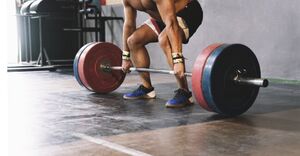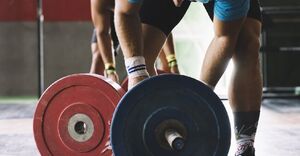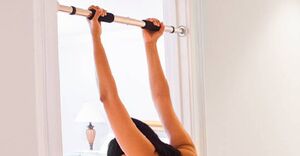
7 Powerful Benefits of Training with Freestanding Pull-Up Bars
If one is interested in enhancing their fitness routine, using a freestanding pull-up bar may be beneficial. This article discusses the seven key advantages of integrating a freestanding pull-up bar into workouts. These benefits range from enhancing upper body strength, improving grip strength, and targeting various muscle groups.
Additionally, the article explores different exercises that can be performed using a freestanding pull-up bar and offers guidance on selecting the most suitable one for individual needs. This versatile equipment can play a significant role in helping individuals achieve their fitness objectives.
What Are the Benefits of Training with a Freestanding Pull-Up Bar?
Training with a freestanding pull-up bar provides numerous benefits for one’s fitness journey, such as improving muscle strength, core stability, and offering a variety of workout options in the convenience of one’s home.
By including a freestanding pull-up bar in a fitness routine, it allows for targeted muscle engagement in the upper body, focusing on the back, arms, and shoulders. Consistent use of this equipment can lead to notable enhancements in overall strength and endurance.
The versatility of freestanding pull-up bars enables the execution of various bodyweight exercises, like hanging leg raises, dips, and knee raises, to further improve core stability and fitness level. With their durable design, these pull-up bars ensure longevity, making them a dependable investment for a home gym setup.
1. Build Upper Body Strength
Developing muscle mass and enhancing overall strength can be achieved through freestanding pull-up bar exercises, which are essential for building upper body strength.
Including pull-up bar exercises in a workout regimen can effectively target key muscle groups such as the back, arms, and shoulders. Variations like wide grip pull-ups emphasize the lats, while close grip pull-ups activate the biceps and forearms. To advance in training, individuals can explore assisted pull-ups using resistance bands or aim for more challenging movements like muscle-ups. Incorporating chin-ups, where the palms face inward, can offer a different stimulus for muscle growth.
Consistent practice and maintaining proper form during pull-up bar workouts can assist individuals in reaching their strength and fitness objectives.
2. Improve Grip Strength
Improving grip strength through freestanding pull-up bar exercises offers advantages not only for workouts but also for enhancing overall functional fitness.
A strong grip is crucial for executing a variety of exercises like deadlifts, rows, and everyday tasks such as lifting groceries or opening jars. By adding pull-up bar exercises like hanging knee raises and dead hangs to your regimen, you can target the muscles in your hands, forearms, and wrists. These exercises not only work on enhancing grip strength but also contribute to building stability and coordination across your body, resulting in better overall performance in various physical activities.
3. Target Multiple Muscle Groups
Participating in pull-up bar exercises enables individuals to target multiple muscle groups simultaneously, offering an efficient method of strengthening various areas of the body. Integrating compound movements like pull-ups into a routine engages major muscle groups like the back, shoulders, and arms, providing a comprehensive workout that enhances functional strength and coordination.
Additionally, pull-ups can activate stabilizing muscles in the core and enhance grip strength, leading to improved overall physical performance. This form of exercise contributes to the development of a robust and well-rounded physique, establishing it as a crucial element of a comprehensive fitness regimen.
4. Increase Core Stability
Improving posture, enhancing balance, and preventing injuries during workouts requires working on core stability through pull-up bar exercises.
Incorporating pull-up bar exercises into a fitness routine can strengthen the deep core muscles that support the spine and pelvis, leading to better stability and alignment. Engaging the core while performing exercises like hanging leg raises, knee tucks, and windshield wipers on the pull-up bar effectively targets key muscles such as the rectus abdominis, obliques, and transverse abdominis. Developing a strong core not only enhances athletic performance but also assists in everyday activities like lifting heavy objects, maintaining good posture, and reducing the risk of back pain.
5. Versatile Workout Options
Freestanding pull-up bars offer a range of workout options that allow customization of fitness routines with different exercises, progressions, and challenging pull-up variations. These pull-up bars are not limited to traditional pull-ups but also provide opportunities for engaging in exercises like chin-ups, hanging leg raises, knee tucks, and muscle-ups.
Beginners can benefit from assisted pull-ups using resistance bands to build strength and technique, while advanced users can try one-arm pull-ups, plyometric pull-ups, and towel grip pull-ups to enhance upper body strength and muscle definition.
6. Convenient and Space-Saving
Incorporating a freestanding pull-up bar into home gym equipment offers the convenience of a space-saving, portable workout station that is easy to assemble and suitable for indoor workouts.
This versatile piece of fitness equipment allows individuals to engage in effective upper body workouts without taking up a lot of space. Its freestanding design enables users to set it up in any room, making it ideal for homes with limited space or shared living areas. The portable nature of the pull-up bar makes it easy to move around for different exercises or to store away when not in use. Its compact design ensures efficient use of home gym space, providing a practical solution for those looking to optimize their workout area.
7. Cost-Effective Option
Choosing a freestanding pull-up bar for your home gym equipment is a cost-effective option that offers durable fitness equipment suitable for both indoor and outdoor workouts.
These freestanding pull-up bars are built to endure different weather conditions, making them ideal for outdoor use without concerns about rust or corrosion. Unlike gym memberships or costly exercise machines, investing in a freestanding pull-up bar provides long-term value with low maintenance needs. The versatility of pull-up bars enables a variety of exercises targeting various muscle groups, offering a comprehensive workout experience in the comfort of your home.
What Exercises Can You Do with a Freestanding Pull-Up Bar?
A freestanding pull-up bar can provide a wide range of exercise options, helping individuals achieve a full-body workout, increase muscle mass, and improve fitness levels through challenging bodyweight exercises.
With a freestanding pull-up bar, users can target multiple muscle groups simultaneously by incorporating exercises like hanging leg raises for core strength, chin-ups for biceps and back muscles, and hanging knee tucks for lower abs.
By including variations such as wide-grip pull-ups, commando pull-ups, and L-sit pull-ups, users can focus on different areas of the upper body while also enhancing grip strength.
Additionally, utilizing the pull-up bar for inverted rows or Australian pull-ups can further strengthen the back and arm muscles, contributing to a comprehensive and effective workout routine.
1. Pull-Ups
Pull-ups are considered a beneficial bodyweight exercise that targets multiple muscle groups and aids in improving posture while offering a comprehensive full-body workout.
Regular engagement in pull-up routines may result in increased strength in the back, shoulders, arms, and core. Maintaining proper form throughout pull-ups can also lead to enhancements in overall posture, potentially reducing the likelihood of developing postural issues. To optimize the advantages, emphasizing controlled movements and minimizing swinging can effectively isolate the targeted muscles. Incorporating variations such as wide-grip, narrow-grip, or weighted pull-ups can present challenges suitable for various fitness levels and facilitate progress in strength development.
2. Chin-Ups
Pull-ups, when done using a freestanding pull-up bar, are an effective way to build upper body strength, improve grip strength, and work multiple muscle groups simultaneously.
Chin-ups are a versatile exercise that can be adjusted to accommodate different fitness levels. Beginners may choose to begin with assisted chin-ups by using a resistance band to decrease body weight resistance. As strength progresses, variations like wide-grip chin-ups, commando chin-ups, or weighted chin-ups can be introduced to consistently challenge the muscles and further improve overall upper body strength. These variations target various muscle groups in the arms, shoulders, and back, offering a comprehensive workout for individuals at different fitness levels.
3. Hanging Leg Raises
Hanging leg raises, when done on a freestanding pull-up bar, are effective for targeting core muscles, increasing muscle mass, and improving overall body strength.
Participating in this exercise allows individuals to work on lower abs, hip flexors, and obliques. The correct technique involves hanging from the pull-up bar with a secure grip, then lifting the legs slowly and steadily until they are parallel to the ground before lowering them back down.
To make the workout more challenging, individuals can try variations like twisting the legs to focus on the obliques or incorporating ankle weights for added resistance. Consistency and proper form play a crucial role in maximizing the benefits of hanging leg raises and attaining a strong, defined core.
4. Inverted Rows
Performing inverted rows using a freestanding pull-up bar is an effective bodyweight exercise that targets the core muscles, promotes functional fitness, and boosts overall strength. These rows engage multiple muscle groups simultaneously, including the back, arms, and shoulders, making them a beneficial compound exercise. By activating the core to stabilize the body during the movement, inverted rows aid in improving balance and posture.
Beginners may opt to start with a higher bar or adjust the angle to decrease the intensity, while more experienced individuals can ramp up the difficulty by lowering the bar or raising the feet. To add more challenge, progressions such as single-arm rows or incorporating a weight vest can further intensify the workout for those seeking increased difficulty.
5. L-Sits
L-sits performed on a freestanding pull-up bar are exercises that provide a challenge and target core strength, stability, and bodyweight resistance, ultimately improving overall fitness level.
These movements engage various muscle groups, including the abdominal muscles, hip flexors, lower back, and shoulders, which can lead to better posture and balance. To perform an L-sit correctly, one should begin by sitting on the ground with hands placed shoulder-width apart on the bar, then lift the body off the ground while keeping the legs straight. Beginners may find it beneficial to start with bent knees or use parallel bars for support as they work towards mastering this advanced core exercise through consistent practice and patience.
How to Choose the Right Freestanding Pull-Up Bar for You?
Choosing the right freestanding pull-up bar involves considering factors such as adjustable height, stability, and versatility to ensure it aligns with your specific training requirements and objectives.
Adjustable features play a vital role as they enable customization of the height based on your stature and the types of exercises you intend to engage in. A pull-up bar with multiple height options can cater to individuals of different sizes and fitness levels, making it a versatile choice. Stability is equally important for safety during rigorous workout sessions; opting for a bar with a broad, solid base and non-slip grips can prevent any instability. It is also beneficial to assess the versatility of the pull-up bar, as certain models offer additional attachments for exercises like dips, push-ups, and leg raises, thereby broadening the range of workout options available.
1. Consider Your Space and Budget
When choosing a freestanding pull-up bar, it is important to consider your available space and budget to ensure it integrates well into your home gym setup for convenient indoor or outdoor workouts.
Analyzing the space in your home gym is essential to ensure that the pull-up bar fits into your workout area without overcrowding it. Establishing a budget before making a purchase decision can help narrow down your options and prevent excessive spending. By selecting a cost-effective yet durable freestanding pull-up bar, you can benefit from a versatile training tool that works well both indoors and outdoors, giving you the flexibility to change your workout environment as needed.
2. Check for Sturdiness and Weight Capacity
It is important to prioritize the sturdiness and weight capacity of a freestanding pull-up bar to ensure it can adequately support workouts and provide stability for safe training sessions.
When selecting a pull-up bar, consider the durability of the materials used in its construction. Opt for high-quality steel or metal frames that can endure the strain and weight of exercises. Look for reinforced joints and sturdy weld points, as these factors contribute significantly to the overall strength and stability of the equipment.
When assessing weight capacity, make sure the bar can comfortably support your body weight and any additional resistance, such as weight belts or vests, to minimize the risk of breakage or tipping over.
3. Look for Adjustable Features
Choose a freestanding pull-up bar that comes with adjustable features like height settings. This will allow you to accommodate various exercises and workout intensities, providing versatility in your fitness routine.
By being able to adjust the height settings, you can easily tailor the pull-up bar to meet your specific needs and preferences. This feature enables you to target different muscle groups and adjust the difficulty level of your workouts.
Whether your focus is on enhancing upper body strength, working on core muscles, or improving overall fitness, a freestanding pull-up bar with adjustable features can address all these requirements. Its versatility offers a wide range of workout options, making it a valuable addition to your home gym equipment.
4. Consider Additional Features or Attachments
Consider looking into freestanding pull-up bars that come with additional features or attachments to enhance your workouts. These may include dip bars, suspension straps, or resistance bands, providing added training variety.
These extra features and attachments not only add versatility and challenge to your routine but also target different muscle groups for a more well-rounded workout. Incorporate dip bars for tricep and chest engagement or use suspension straps to improve core stability and balance for a full-body strength training session.
Resistance bands offer adjustable resistance levels, ideal for progressive overload and muscle growth. By integrating these enhancements into your routine, you can elevate your fitness regimen and work towards achieving your goals more effectively.
Tips for Safe and Effective Training with a Freestanding Pull-Up Bar
For optimal benefits when training with a freestanding pull-up bar, the following tips can help ensure safe and effective workouts that align with your fitness goals and progression.
- A key element of using a freestanding pull-up bar is incorporating a comprehensive warm-up routine to prepare your muscles and joints for the upcoming workout. It is important to engage in dynamic stretches and movements that target the muscles used in pull-ups.
- Maintaining proper exercise form is crucial to prevent injuries and optimize the efficiency of each repetition. Concentrate on keeping a neutral spine, activating your core, and executing controlled movements throughout the exercise.
- Gradually increasing the intensity of your pull-up workouts can aid in safe progression and help you avoid overexertion. It’s important to pay attention to any signals from your body – if you feel pain or discomfort, it’s necessary to take a step back and evaluate your technique.
- Incorporating sufficient rest days into your training schedule allows your muscles to recover and become stronger, ultimately leading to the best possible outcomes.
1. Warm Up Properly
It is important to prioritize proper warm-up routines before using a freestanding pull-up bar. This preparation is essential to ready your muscles, prevent injuries, and optimize the effectiveness of your workout session.
This crucial step can significantly impact your overall performance and minimize the risk of strains or sprains. To begin, incorporate dynamic stretches like arm circles, leg swings, and torso twists. These stretches help increase blood flow and flexibility in your shoulders, back, and core muscles.
In addition, include activation exercises such as scapular retractions and plank variations. These exercises further engage the specific muscle groups involved in pull-ups, preparing them for the upcoming challenge. A comprehensive warm-up not only enhances physical readiness but also improves your mind-muscle connection, ensuring proper form and maximum gains from your pull-up bar workout.
2. Use Proper Form
Maintaining proper exercise form while using a freestanding pull-up bar is crucial to prevent injuries, target muscle groups effectively, and maximize the benefits of each workout.
Focusing on correct posture is essential when performing pull-ups on a freestanding bar. Keeping the back straight, shoulders pulled back, and engaging the core throughout the movement is key. Being mindful of grip variations is also important, as different hand placements can target specific muscle groups.
For example, a wide grip emphasizes the lats, while a close grip focuses more on the biceps. Paying attention to movement technique by controlling the descent phase helps avoid swinging or jerking motions. Using proper form not only reduces the risk of injury but also contributes to improving overall performance and strength gains.
3. Gradually Increase Intensity
Gradually increase the intensity of freestanding pull-up bar workouts by incorporating workout progressions and challenging variations to promote muscle adaptation and continuous fitness improvement.
As individuals progress in their fitness journey, it is important to challenge the body with new exercises and increased difficulty levels. Beginners can start with assisted pull-ups or inverted rows to build strength before advancing to standard pull-ups. Intermediate fitness enthusiasts may include negative pull-ups or variations like wide grip or chin-up grip pull-ups. Advanced individuals may opt for weighted pull-ups or explosive pull-up variations such as muscle-ups to elevate their workout routine. Consistency and gradual progression play vital roles in achieving fitness goals.
4. Listen to Your Body
Developing body awareness during freestanding pull-up bar workouts is crucial to understanding your body’s signals, avoiding overtraining, and making necessary adjustments to your exercises based on your physical capabilities.
By being in tune with your body, you can prevent injuries and ensure your training remains effective. Overtraining can impede progress and result in burnout, so it is important to find a balance.
Incorporating rest days, utilizing recovery techniques like foam rolling and stretching, and maintaining proper hydration are all essential elements of a comprehensive fitness routine. Progress is not solely about pushing yourself relentlessly; it also involves recognizing when to ease off and allow your body the opportunity to recover and become stronger.
5. Incorporate Rest Days
It is important to include sufficient rest days in a training routine that involves using a freestanding pull-up bar. This allows for muscle repair, recovery, and overall fitness progress without risking burnout or injury.
Rest days are not just a break from training; they are a crucial component that aids in muscle recovery and growth. By providing your body with time to repair and rebuild after intense pull-up bar sessions, you can enhance your strength and performance. To optimize rest days, focus on activities that promote active recovery, such as stretching, yoga, or light cardio. Pay attention to your sleep and nutrition, as these factors are essential in supporting your body’s healing process during rest days.
External Resources: https://nutroone.com/en/product-category/fitness-accessories/pull-up-bar/




No Comments